Ever had an ice cream bean for dessert?
Seed Morphologist, Wolfgang Stuppy, has us salivating over the remarkable fruits of the ice cream bean (Inga edulis).

Ever since I can remember I have been fascinated by plants, especially all things edible that come from them. And the more exotic the plant, the better! After blogging about the cashew nuts, a very well-known exotic treat, I decided to now choose a seedy delicacy that is less well-known, at least in our temperate climate.
Sweet seeds
The legume family (Leguminosae or Fabaceae) is an amazingly diverse (nearly 20,000 species worldwide!) and incredibly useful group of plants. They feed us with beans, peas, lentils, soya and loads of other pulses and they treat us with delicious peanuts, tamarinds and liquorice. When travelling to far-away tropical countries, we are likely to encounter lesser spotted members of this miraculous family and some of them bear strange-looking but excitingly delicious fruits. One of these scrumptious exotics is the South American ice cream bean, Inga edulis, locally called ‘guaba’ (pronounced ‘wuba’). Behind this mouth-watering name lies a beautiful tree with a remarkable fruit.
A two metre long candy bar!
Reaching a height of up to 30m (96ft), an ice cream bean tree produces cylindrical and often spirally twisted bean-like pods that grow up to more than two metres(!) in length. This is no hoax! One of my colleagues at Kew, Dr. Terry Pennington, is a specialist on the genus Inga. Whilst discussing this blog with him, he told me that he was supervising Inga trials in Amazonian Peru in the early 90’s, they had a competition on the local radio to find the longest ice cream bean. The winner brought one which measured 2.07 m long.
Inside, lined up in one row, the pods contain numerous large purple-black seeds embedded in an edible, translucent-white pulp. The sweet flavour of the spongy pulp resembles that of vanilla ice cream, hence the name. Basically a yard-long candy bar that grows on a tree, most people will be sufficiently impressed by the size of this fruit and its delicious flavour. As a practicing ‘seed nerd’, however, I find something else quite extraordinary, too.
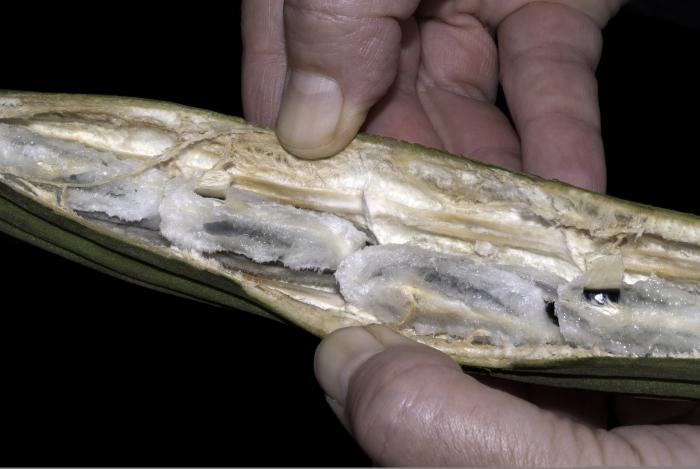
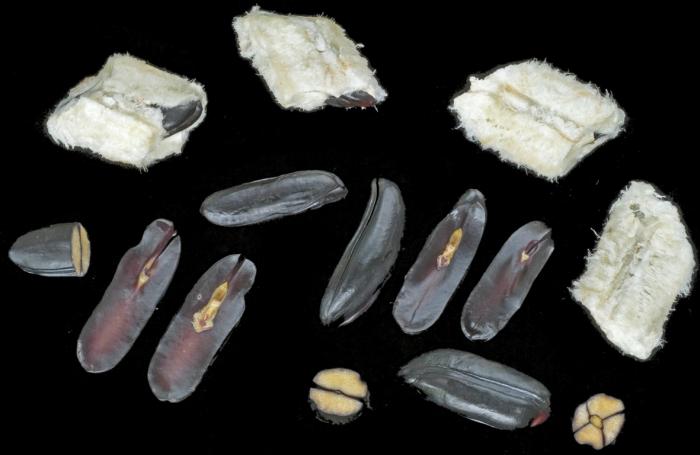
Unlike most fleshy fruits, the sweet pulp of the ice cream bean is not produced by the fruit wall but by the seed itself. Usually, seeds are covered by a hard seed coat to protect the precious embryo inside against both the elements and hoards of seed-eating critters. In the ice cream bean, however, the entire seed coat becomes soft and fleshy. Once you have nibbled a hole in it at one end, you can basically strip it off like a sock and suck the sugary treat! What remains is the purple-black embryo. Although it looks very dark on the outside, underneath its black skin, the embryo is actually green.
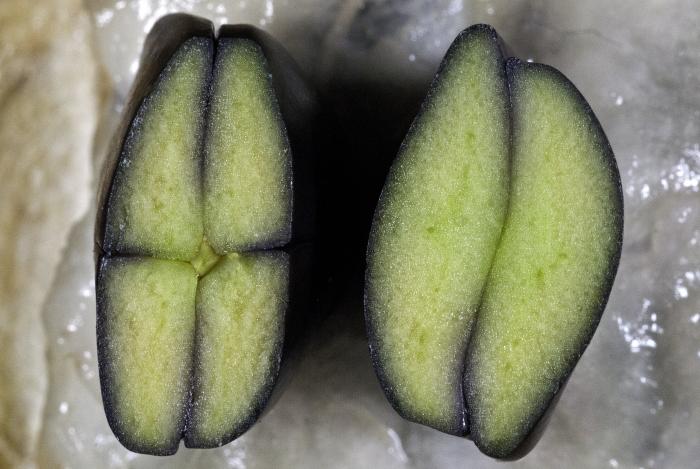
The genus Inga contains about 300 species of shrubs and trees, all native to the warm and tropical parts of the Americas (including the Antilles) and most of them occurring in the Amazon rainforest. Although Inga edulis (edulis meaning ‘edible’) is the most common species that is referred to as ‘ice cream bean’, there are a number of other Inga species that spoil us with equally delicious fruits, for example Inga feuillei (called ‘pacay’ in Peru), I. rhynchocalyx, and I. spectabilis. Their fruits differ in shape and size but inside they are very similar.
Because of their delicious taste, ice cream beans are very popular in many parts of Central and South America, where they are almost always eaten raw. During the tropical wet season when fruits are abundant, monkeys and birds feast on the sweet pulp and scatter the soft embryos.
But aside from their edible fruits, Inga trees are also useful in other respects. Like many members of the legume family, Inga trees have the ability to fix nitrogen with the help of Rhizobium bacteria which they house in specialized root nodules. Because they introduce nitrogen from the air into the soil, these root nodules act like fertilizer and help to improve soil fertility. Moreover, Inga trees have long been grown by indigenous Amazonians for food, shade and timber and they have also proven very useful as shade trees in cacao, coffee, tea, black pepper and vanilla plantations.
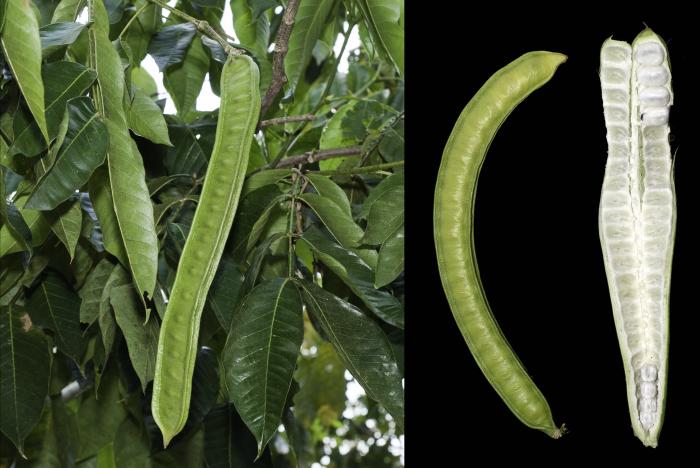
But it’s not only the fruits that make Inga trees so very special. Their flowers, which produce the delicious ice cream beans, are pretty amazing too. They only open for one night and wither very quickly in the early morning. Like many other nocturnal flowers, they are large, white in colour and arranged in dense clusters (inflorescences). The individual flowers consist mainly of a brush-like tuft of stamens with long filaments. Flowers of this type are typically pollinated by bats. Their furry faces get powdered with pollen as they search for nectar at the base of the flower. Recent research into Inga has shown that at least in some species (e.g. Inga sessilis), hummingbirds are the first visitors just after the flowers open, followed by bats as well as hawkmoths throughout the night.
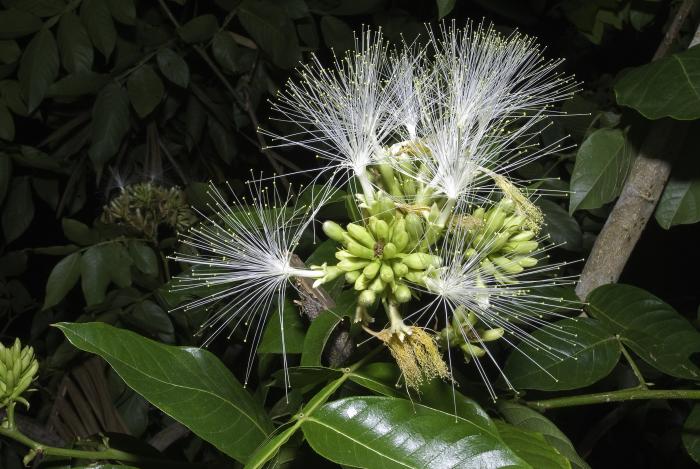
One last thing...
In my blog post on the cashew nut I was raving about eating embryos and how delicious they are. Those of you who read this blog might wonder as to why the birds and monkeys that feast on ice cream beans don’t also eat the embryos wrapped inside the juicy seed coat. Good question indeed since hungry animals usually devour everything they find palatable and digestible. The answer to this is not only a fascinating example of the co-evolution between plants and animals but also a lively illustration of how plants pursue different strategies to achieve the same goal: in seeds it’s all about the safe dispersal of their embryos.
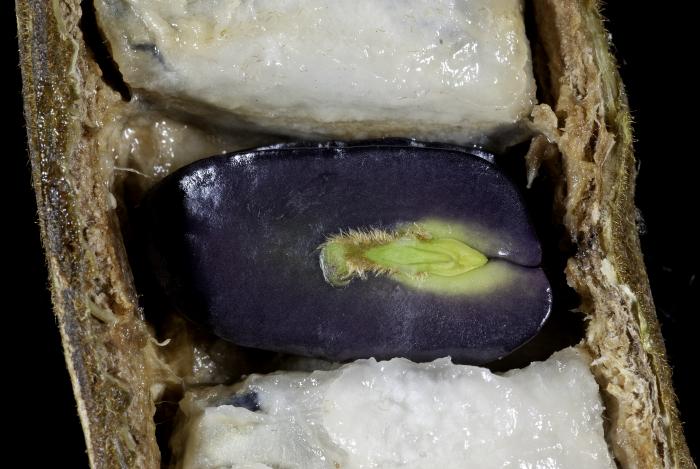
When it comes to protecting their seeds, animal-dispersed fruits that offer edible rewards to attract animal dispersers have two options to increase the chances of their seeds to escape destructive mastication: mechanical or chemical protection. Plainly this means that either seeds are encased in a really hard shell or they are laced with bitter-tasting substances (usually tannins) and/or poisonous chemicals that teach uninitiated animals enjoying a particular fruit for the first time a lesson they won’t soon forget. If you need experimental evidence for this, try chewing the seeds of grapes, apples, oranges, avocados or papayas. In the unlikely event that you actually enjoy the experience, please do note that the seeds of apples and other members of the rose family (e.g. plums, apricots and bitter almonds) contain highly toxic cyanide (actually a cyanogenic glycoside called amygdalin, to be precise).
But fear not! You are unlikely to have sufficient apple seeds at your disposal to actually poison yourself. For example, one kg of Fuji apple seeds contain the equivalent of c. 700-800 mg hydrocyanic acid (see this article from Food Chemistry for more information). When ingested, the lethal dose is about 50 mg of cyanide (depending on your body weight) so you would have to eat about 60-70 g of fresh apple seeds. That doesn’t sound like a lot but how many seeds is that? Since I couldn’t find any reliable figures for the weight of an average apple seed, I chopped up my Braeburn that I bring for lunch every day. I found three seeds in it that weighed 211 mg altogether, so that’s 70 mg per seed. To get to the potentially ‘lethal dose’ of 70 grams of seeds I would need 1,000 apple seeds. My cherished lunchtime Braeburn yielded only three fully developed seeds so I would need over 300 more Braeburns before I could contemplate to seriously poison myself. Hmh...
Returning to the actual matter of this blog, in the case of the ice cream bean this means that in the absence of even the slightest mechanical protection, the embryo is almost without doubt (I haven’t tried it!) very bad-tasting, usually bitter, if not actually poisonous.
- Wolfgang -
All photographs by Wolfgang Stuppy